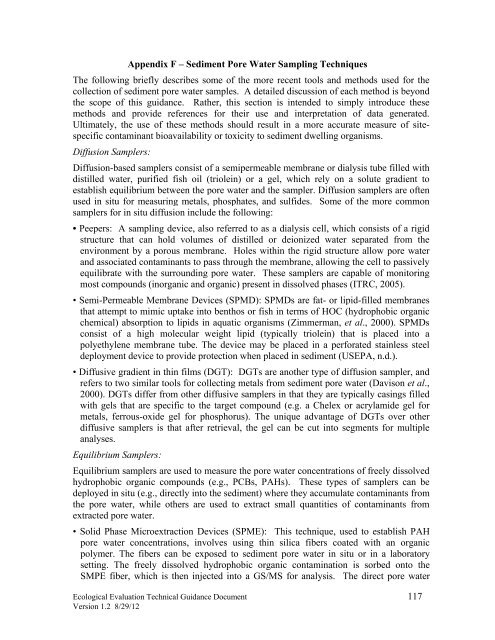Ecological Evaluation Technical Guidance - State of New Jersey
Ecological Evaluation Technical Guidance - State of New Jersey
Ecological Evaluation Technical Guidance - State of New Jersey
- No tags were found...
Create successful ePaper yourself
Turn your PDF publications into a flip-book with our unique Google optimized e-Paper software.
Appendix F – Sediment Pore Water Sampling TechniquesThe following briefly describes some <strong>of</strong> the more recent tools and methods used for thecollection <strong>of</strong> sediment pore water samples. A detailed discussion <strong>of</strong> each method is beyondthe scope <strong>of</strong> this guidance. Rather, this section is intended to simply introduce thesemethods and provide references for their use and interpretation <strong>of</strong> data generated.Ultimately, the use <strong>of</strong> these methods should result in a more accurate measure <strong>of</strong> sitespecificcontaminant bioavailability or toxicity to sediment dwelling organisms.Diffusion Samplers:Diffusion-based samplers consist <strong>of</strong> a semipermeable membrane or dialysis tube filled withdistilled water, purified fish oil (triolein) or a gel, which rely on a solute gradient toestablish equilibrium between the pore water and the sampler. Diffusion samplers are <strong>of</strong>tenused in situ for measuring metals, phosphates, and sulfides. Some <strong>of</strong> the more commonsamplers for in situ diffusion include the following:• Peepers: A sampling device, also referred to as a dialysis cell, which consists <strong>of</strong> a rigidstructure that can hold volumes <strong>of</strong> distilled or deionized water separated from theenvironment by a porous membrane. Holes within the rigid structure allow pore waterand associated contaminants to pass through the membrane, allowing the cell to passivelyequilibrate with the surrounding pore water. These samplers are capable <strong>of</strong> monitoringmost compounds (inorganic and organic) present in dissolved phases (ITRC, 2005).• Semi-Permeable Membrane Devices (SPMD): SPMDs are fat- or lipid-filled membranesthat attempt to mimic uptake into benthos or fish in terms <strong>of</strong> HOC (hydrophobic organicchemical) absorption to lipids in aquatic organisms (Zimmerman, et al., 2000). SPMDsconsist <strong>of</strong> a high molecular weight lipid (typically triolein) that is placed into apolyethylene membrane tube. The device may be placed in a perforated stainless steeldeployment device to provide protection when placed in sediment (USEPA, n.d.).• Diffusive gradient in thin films (DGT): DGTs are another type <strong>of</strong> diffusion sampler, andrefers to two similar tools for collecting metals from sediment pore water (Davison et al.,2000). DGTs differ from other diffusive samplers in that they are typically casings filledwith gels that are specific to the target compound (e.g. a Chelex or acrylamide gel formetals, ferrous-oxide gel for phosphorus). The unique advantage <strong>of</strong> DGTs over otherdiffusive samplers is that after retrieval, the gel can be cut into segments for multipleanalyses.Equilibrium Samplers:Equilibrium samplers are used to measure the pore water concentrations <strong>of</strong> freely dissolvedhydrophobic organic compounds (e.g., PCBs, PAHs). These types <strong>of</strong> samplers can bedeployed in situ (e.g., directly into the sediment) where they accumulate contaminants fromthe pore water, while others are used to extract small quantities <strong>of</strong> contaminants fromextracted pore water.• Solid Phase Microextraction Devices (SPME): This technique, used to establish PAHpore water concentrations, involves using thin silica fibers coated with an organicpolymer. The fibers can be exposed to sediment pore water in situ or in a laboratorysetting. The freely dissolved hydrophobic organic contamination is sorbed onto theSMPE fiber, which is then injected into a GS/MS for analysis. The direct pore water<strong>Ecological</strong> <strong>Evaluation</strong> <strong>Technical</strong> <strong>Guidance</strong> Document 117Version 1.2 8/29/12
















